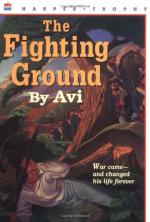|
This section contains 343 words (approx. 1 page at 400 words per page) |

|
Two literary devices that Avi uses to establish theme and tone are titling the novel's brief chapters by the time of day and giving characters no names or identities other than a generic title, such as the young Hessian, the Corporal, and the old soldier. Both techniques establish the alienation that Jonathan experiences during his day at war. By not naming characters other than Jonathan, Avi suggests the impersonality of war. People are pawns with designated functions; war forces them to give up their individual identities and their capacity to form human relationships.
Nineteenth-century author Stephen Crane's Red Badge of Courage, considered the first modern war novel, incorporates a very similar technique. The three principal characters are almost always referred to as "the youth," "the tall soldier," and "the loud soldier." Like Jonathan, Crane's protagonist is a young man who envisions war as a glorious adventure...
|
This section contains 343 words (approx. 1 page at 400 words per page) |

|




